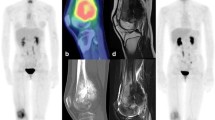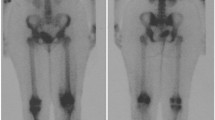Abstract
Objective
To describe the technique, applications and advantages of 18FDG PET scanning in detection, analysis and management of musculoskeletal lesions.
Design and patients
Forty-five patients (19 males,26 females) aged 9 to 81 years had radiographs, routine radionuclide scans, CT and/or MRI of clinically suspected active benign or malignant musculoskeletal lesions. 18FDG scans with a Siemens ECAT EXACT 921 dedicated PET unit (Knoxville, Tenn.) and FWH=6 mm images acquired as a 5–6 bed examination (6 min emission and 4 min transmission) used OSEM iterative reconstruction with segmented transmission attenuation correction and a Gaussian filter (cutoff 6.7 mm). Region of interest (ROI) 3×3 pixel image analysis based on transverse whole body images (slice thickness 3.37 mm) generated Maximum Standard Uptake Values (Max SUV) with a cutoff of 2.0 used to distinguish benign and malignant lesions.
Results
Thirty-nine studies were available for SUV ROI analysis. Overall sensitivity for differentiating malignant from benign osseous and non-osseous lesions was 91.7% (22/24), overall specificity was 100% (11/11) with an accuracy of 91.7%. All aggressive lesions had a Max SUV >2.0. Data separating benign from malignant lesions and aggressive from benign lesions were statistically significant (P<0.001) in both categories. There was no statistically significant difference in distinguishing aggressive from malignant lesions (P, ns).
Conclusion
18FDG PET contributes unique information regarding metabolism of musculoskeletal lesions. By supplying a physiologic basis for more informed treatment and management, it influences prognosis and survival. Moreover, since residual, recurrent or metastatic tumors can be simultaneously documented on a single whole body scan, PET may theoretically prove to be cost-effective.







Similar content being viewed by others
References
Blau M, Nagler W, Bender MA. Fluorine-18 a new isotope for bone scanning. J Nucl Med 1962; 3:332–334.
Som P, Atkins, HL, Bandaypadhyay D, et al. A fluorinated glucose analog, 2-fluoro-2-glucose (F18): nontoxic tracer for rapid tumor detection. J Nucl Med 1980; 21:670–675.
Warburg O. The metabolism of tumors. London: Constable, 1930:75–327.
Schulte M, Brecht-Krauss D, Heymer B, et al. Grading of tumors and tumor-like lesions of bone: evaluation by FDG PET. J Nucl Med. 2000; 41:1695–1701.
Aoki J, Watanabe H, Shinozaki T, et al. FDG PET of primary benign and malignant bone tumors: standardized uptake value in 52 lesions. Radiology 2001; 219:774–777.
Schirrmeister H, Guhlmann A, Elsner K, et al. Sensitivity in detecting osseous lesions depends on anatomic localization: planar bone scintigraphy versus18F PET. J Nucl Med. 1999;40:1623–1629.
Sasaki M, Ichiya Y, Kuwabara Y, et al. Fluorine-18 fluorodeoxglucose positron emission tomography in technetium 99m hydroxymethylenediphosphate negative bone tumors. J Nucl Med 1993; 34:288–290.
Garcia R, Kim EE, Wong FC, et al. Comparison of fluorine-18 FDG PET and technetium-99m-MIBI SPECT in evaluation of musculoskeletal sarcomas. J Nucl Med 1996; 37:1476–1479.
Abdel-Dayem HM. The role of nuclear medicine in primary bone and soft tissue tumors. Semin Nucl Med. 1997; 27:355–363.
Kole AC, Nieweg OE, VanGinkel RJ, Pruim J, et al. Detection of local recurrence of soft-tissue sarcoma with positron emission tomography using 18-F fluorodeoxyglucose. Ann Surg Oncol 1997; 4:57–63.
Schwartzbach M, Willeke F, Dimitrakopoulou-Strauss A, et al. Functional imaging and detection of local recurrence in soft tissue sarcomas by position emission tomography. Anticancer Res 1999; 19:1343–1350.
Kern KA, Brunetti A, Nortn JA, et al. Metabolic imaging of human extremity musculoskeletal tumors by PET. J Nucl Med 1988; 29:181–186.
Kole AC, Nieweg OE, Hoekstra HJ, et al. Fluorine-18 fluorodeoxyglucose assessment of glucose metabolism in bone tumors. J Nucl Med 1998; 39:810–815.
Adler LP, Blair HF, Williams RP, et al. Grading liposarcoma with PET using (18F)FDG. J Comput Assist Tomogr 1990; 14:960–962.
Adler LP, Blair HF, Makley JT, et al. Noninvasive grading of musculoskeletal tumors using PET. J Nucl Med 1991; 32:1508–1512.
Nieweg OE, Pruim J, VanGinkle RJ, et al. Fluorine-18 fluorodeoxyglucose PET imaging of soft tissue sarcoma. J Nucl Med 1996; 37:257–261.
Griffeth LK, Dehdashti FD, McGire AH, et al. PET evaluation of soft-tissue masses with fluorine-18 fluoro-2-deoxy-d-glucose. Radiology 1992; 182:185–194.
Lodge MA, Lucas JD, Marsken PK, et al. A PET study: 18-FDG uptake in soft tissue masses. Eur J Nucl Med 1999; 26:22–30.
Lucas JD, O'Doherthy MJ, Wong JC, et al. Evaluation of fluorodeoxyglucose positron emmision tomography in the management of soft tissue sarcomas. J Bone Joint Surg Br 1998; 80:441–447.
Matthias HM, Schwarzback MD, Dimitrakopoulou-Strauss A, et al. Clinical value of (18F)fluorodeoxyglucose positron emission tomography imaging in soft tissue sarcomas. Ann Surg 2002; 231:380–386.
Eary JF, Conrad E, Bruckner JD, et al. Quantitative (F-18)fluorodeoxyglucose position emission tomography in pretreatment and grading of sarcoma. Clin Cancer Res 1998; 4:1215–1220.
Brudin LH, Valid SO, Rhodes CG, et al. Fluorine-18 deoxyglucose uptake in sarcoidosis measured with positron emission tomography. Eur J Nucl Med 1994; 21:297–305.
Kubota R, Yamada S, Kubota K, et al. Intratumoral distribution of fluorine-18-fluorodeoxyglucose in vivo: high accumulation in macrophages and granulation tissue studies by microautoradiography. J Nucl Med 1992; 33:1972–1980.
Guhlmann A, Brechy-Krauss D, Suger G, et al. Chronic osteomyelitis: detection with FDG PET and correlation with histopathologic findings. Radiology 1998; 206:749–754.
Gamelli RL, Liu H, He L, et al. Augmentation of glucose transporter-1 in macrophages following thermal injury and sepsis in mice. J Leukoc Biol 1996; 59:639–647.
Dehdashti FD, Siegel GA, Griffeth LK, et al. Benign versus malignant intraosseous lesions: discrimination by means of PET with 2-(F-18)fluoro-2-deoxy-d-glucose. Radiology 1996; 200:243–247.
Zasadny KR, Wahl RL. Standardized uptake values of normal tissues at PET with 2-(fluorine-18)-fluoro-2-deoxy-d-glucose: variations with body weight and a method for correction. Radiology 1993; 189:847–850.
Hamberg LM, Hunter GJ, Alpert NM, et al. The dose uptake ratio as an index of glucose metabolism: useful parameter of oversimplification. J Nucl Med 1994; 35:1308–1312.
Wahl RL, Quint LE, Cieslak D, et al. Anatometabolic tumor imaging: fusion of FDG PET with CT or MRI to localize foci of increased activity. J Nucl Med 1993; 34:1190–1197.
Author information
Authors and Affiliations
Corresponding author
Rights and permissions
About this article
Cite this article
Feldman, F., van Heertum, R. & Manos, C. 18FDG PET scanning of benign and malignant musculoskeletal lesions. Skeletal Radiol 32, 201–208 (2003). https://doi.org/10.1007/s00256-003-0623-3
Received:
Revised:
Accepted:
Published:
Issue Date:
DOI: https://doi.org/10.1007/s00256-003-0623-3




